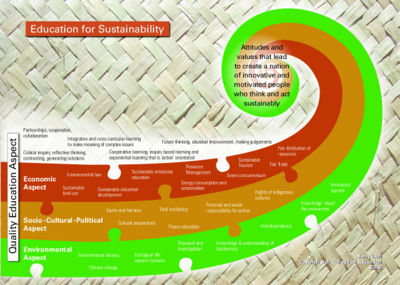 |
| The Education for Sustainability swirl |
In this topic you will be exploring the meaning of sustainability
for your practice and how to be a more sustainable educator. Before you
can do that, it is necessary to understand the concept of sustainability
in an educational context. For example, workload for teachers and
students and the ways in which course materials, activities, assessments
and class interactions can be structured or designed to support
learning which is time and cost-effective and enduring while providing a
high quality experience. The six principles of education in What is Education for?
by David Orr is a good place to start your exploration. For example,
principle 2: The goal of education is not mastery of subject matter, but
of one's person.
Activity Ten – Sustainable Flexible Learning- work on the learning activities - no class time this week.
- How can you become a more sustainable practitioner?
- What sort of learning and teaching strategies meet your philosophy of sustainability?
- Post your reflections about sustainability to your blog once you have viewed the presentations and completed the readings.
- Read the article on student workload
and find out how to calculate it - Lockwood, F. (2005). Estimating
student workload, readability and implications for student learning and
progression. Australia: ODLAA.
- Watch Sir Ken Robinson discuss Do schools kill creativity?: "we are educated out of
creativity not into it". He ends with saying: "we have to educate the
whole person". This 20 minute video is well worth watching.
Two readings are recommended on the
course wiki.

